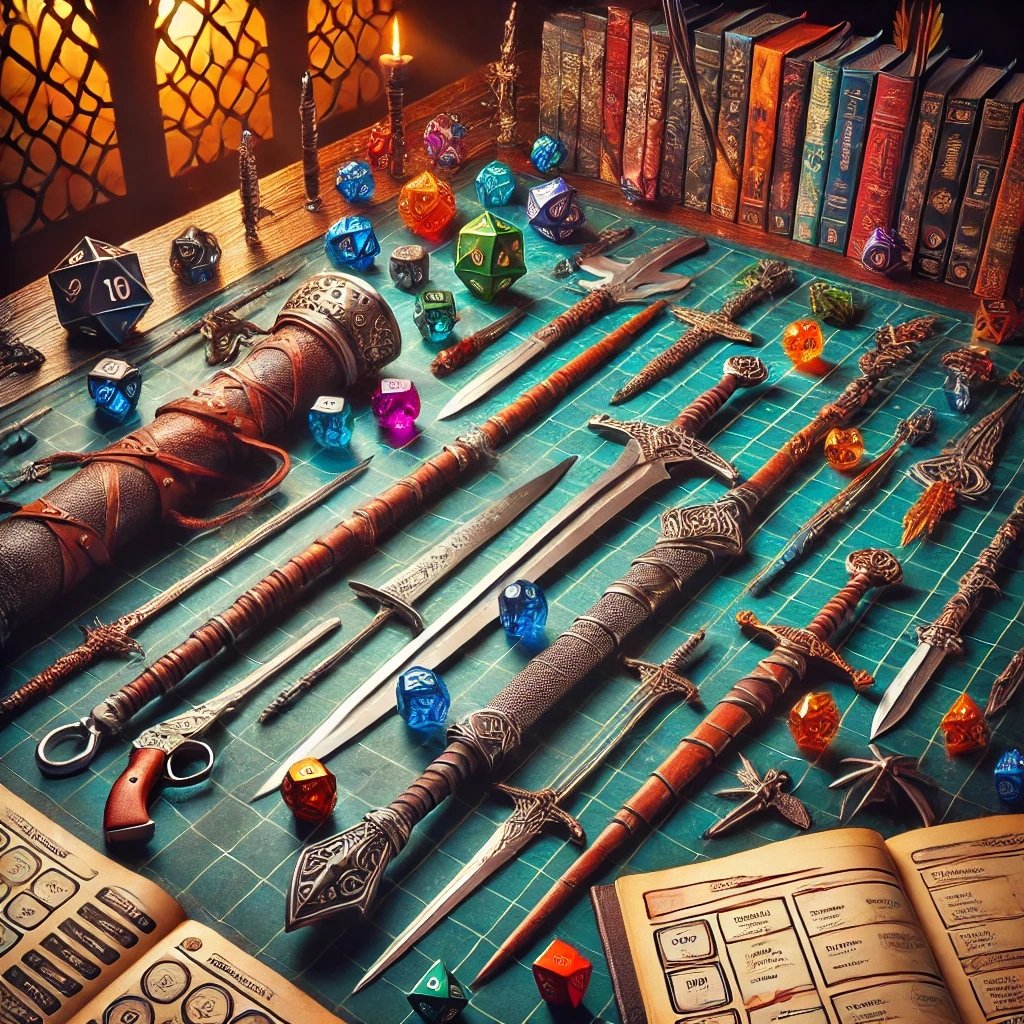Weapons 5e: An In-Depth Guide to D&D 5th Edition Armaments

Weapons are integral to adventuring in Dungeons & Dragons 5th Edition (D&D 5e), shaping combat tactics and character development. Understanding the different types, properties, and strategic uses of these weapons can significantly enhance your gameplay experience.
Categories of Weapons
Weapons in D&D 5e are categorized into two main types: simple and martial.
Simple Weapons
Simple weapons are straightforward and easy to use, often wielded by commoners and novices. These weapons require minimal training and are accessible to most classes. Examples of simple weapons include:
- Club: A basic bludgeoning weapon, easy to craft and wield.
- Dagger: Lightweight and versatile, capable of being thrown or used in melee.
- Greatclub: A larger, two-handed version of the club, dealing more damage.
- Javelin: A throwing spear, effective for both melee and ranged attacks.
Martial Weapons
Martial weapons are more complex and require specialized training. They are commonly used by trained warriors and adventurers seeking to maximize their combat effectiveness. Examples of martial weapons include:
- Longsword: A versatile sword that can be used with one or two hands.
- Battleaxe: A powerful, one-handed axe capable of dealing substantial damage.
- Longbow: A ranged weapon favored by archers for its long reach and precision.
- Halberd: A polearm with reach, effective for keeping enemies at a distance.
Weapon Properties
Each weapon in D&D 5e comes with specific properties that affect its use in combat. Understanding these properties is crucial for making strategic decisions during encounters.
Common Weapon Properties
- Ammunition: Weapons like bows and crossbows require ammunition. You expend one piece of ammunition with each attack.
- Finesse: Allows the use of Dexterity for attack and damage rolls, rather than Strength, ideal for nimble characters.
- Heavy: Large and cumbersome, heavy weapons impose disadvantage on attack rolls when used by Small creatures.
- Light: These are easier to handle, making them suitable for dual-wielding.
- Loading: Limits the weapon to one shot per action, bonus action, or reaction due to the time required to reload.
- Range: Indicates the normal and maximum range for ranged weapons. Attacking beyond the normal range imposes disadvantage.
- Reach: Extends your melee attack range by 5 feet, allowing you to strike from a distance.
- Special: Weapons with unique rules, such as the net, which can restrain targets.
- Thrown: These can be thrown to make ranged attacks, using the same ability modifier as melee attacks.
- Two-Handed: Requires two hands to wield, generally dealing more damage.
- Versatile: Can be used with one or two hands, offering different damage outputs.
Choosing the Right Weapon 5e
Selecting the appropriate weapon for your character involves considering your class, proficiency, and combat style.
Class Proficiencies
Each class in D&D 5e has specific weapon proficiencies that determine which weapons they can use effectively.
- Fighters and Barbarians: Proficient with all simple and martial weapons, allowing them to use a wide variety of armaments.
- Rogues: Typically proficient with simple weapons, hand crossbows, longswords, rapiers, and shortswords, favoring finesse weapons.
- Clerics: Often limited to simple weapons unless their domain grants additional proficiencies.
- Wizards: Usually proficient with a few simple weapons, relying more on spells for combat.
Combat Style and Strategy
Consider your character’s role in combat and preferred fighting style when choosing a weapon.
- Frontline Warriors: Heavy hitters like fighters and barbarians might prefer versatile or two-handed weapons for maximum damage.
- Dexterous Combatants: Rogues and monks benefit from finesse weapons, allowing them to leverage their agility.
- Ranged Specialists: Rangers and archers should prioritize weapons with good range and ammunition properties.
Enhancing Weapons 5e with Magic
In addition to mundane weapons, magical weapons add another layer of strategy and excitement to D&D 5e. These weapons often come with enchantments that grant bonuses to attack and damage rolls, or confer unique abilities.
Examples of Magical Enhancements
- +1 Weapon: Adds a +1 bonus to attack and damage rolls.
- Flame Tongue: A sword that can burst into flames, dealing extra fire damage.
- Frost Brand: A weapon that deals additional cold damage and extinguishes fires on command.
- Vorpal Sword: A legendary sword that can decapitate foes on a critical hit.
Special Weapon 5e Rules
Some weapons come with unique rules and require special consideration.
Improvised Weapons
Improvised weapons are everyday objects used in combat when no standard weapon is available. These can range from a broken bottle to a chair leg, typically dealing 1d4 damage.
Silvered Weapons
Certain creatures have resistance or immunity to non-magical weapons but can be harmed by silvered weapons. Adventurers often invest in silvering their weapons to prepare for such encounters.
Weapons in D&D 5e offer a vast array of choices and strategic opportunities for adventurers. By understanding the categories, properties, and special rules associated with these weapons, players can make informed decisions that enhance their characters’ effectiveness in combat. Whether you wield a simple club or a magical sword, mastering your weaponry is key to surviving and thriving in the world of Dungeons & Dragons.














